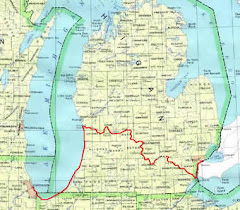
Continuing with my 1999 article in "Michigan History".
LaSalle recounted, "When we had lit a fire on the edge of a prairie we were surrounded by (Pottawatomies), but the man who was on watch awoke us, and we placed ourselves each behind a tree with our guns. The Indians, who are called Ouopous, believed us to be Iroquois, and being convinced that there must be larger numbers of us, since we had not concealed ourselves as they are accustomed to do when they go in small bands, they fled without shooting an arrow". To reinforce the misconception that his band was an Iroquois war party, LaSalle used charcoal from their fire to place marks on tree trunks like those victorious Iroquois used in announcing the taking of scalps and slaves.
To determine LaSalle's route it is important to identify which prairies he and his men crossed the last few days of March 1680. According to the Presettlement Vegetation map, a prairie is an area dominated by prairie grasses and forbs (herbaceous plants) with a tree density of less than one mature tree per acre. One gets the impression from reading Michigan history that Prairie Ronde in southern Kalamazoo County was not only the largest prairie but the only one of real consequence. However, the Presettlement Vegetation map locates forty-nine prairies in the ten-county area it covers. Furthermore, the 1838 Gazetteer of the State of Michigan describes Gull Prairie in northern Kalamazoo County as "the largest body of prairie in the county".
After their escape from the Pottawatomie's, LaSalle's men set fire wherever there was dry grass to obliterate their tracks. In his account of March 29 LaSalle described the prairie they were crossing as being "...four or five leagues broad and so long we could not see the end of it." A league is about 2.75 miles long. This makes the prairie about twelve miles wide. In the early nineteenth century Prairie Ronde was only about five miles across. Certainly the prairies could have been bigger in 1680. They are primarily products of fires that burn off shrubs and tree seedlings, keeping forest encroachment in check. Fewer fires during the 120 years from La Salle's visit until the arrival of the surveyors might explain the difference in the prairies' size. There is another explanation that could justify LaSalle's estimates. Adjacent to Prairie Ronde, Gull Prairie and Grand Prairie were bur-oak openings and oak savannas. Next to those were large and small patches of oak forest. In the case of Gull Prairie, these were far more extensive than around Prairie Ronde. Even Grand Prairie, which was considerably smaller than Prairie Ronde, was surrounded by a significantly larger area of oak openings and savannas.
The Presettlement Vegetation map defines bur-oak openings and oak savannas as having a density of between one and fifteen trees per acre. To a traveler these would seem open and park-like. Some travelers, including James Fenimore Cooper in his "Oak Openings", have likened them to orchards. Even oak forests tend to be quite open and relatively free of underbrush.
If one includes bur-oak openings and oak savannas as part of the prairies LaSalle described, the open country in the Gull Prairie area measures about fourteen miles wide and more than thirty miles from north to south on the Presettlement Vegetationmap. The same exercise in the Prairie Ronde area only measures a width of about nine miles and perhaps twelve from north to south. The Grand Prairie area is about ten miles wide. Considering all these factors, the Gull Prairie area most closely fits LaSalle's size estimate of March 29, 1680.
Given that both Grand Prairie and Gull Prairie are reasonably on line with an easterly exit from the upper end of the Paw Paw River valley, LaSalle most likely did not travel through Prairie Ronde. To have done so would have required a sharp detour to the south.
NEXT: Crossing the Kalamazoo River


No comments:
Post a Comment